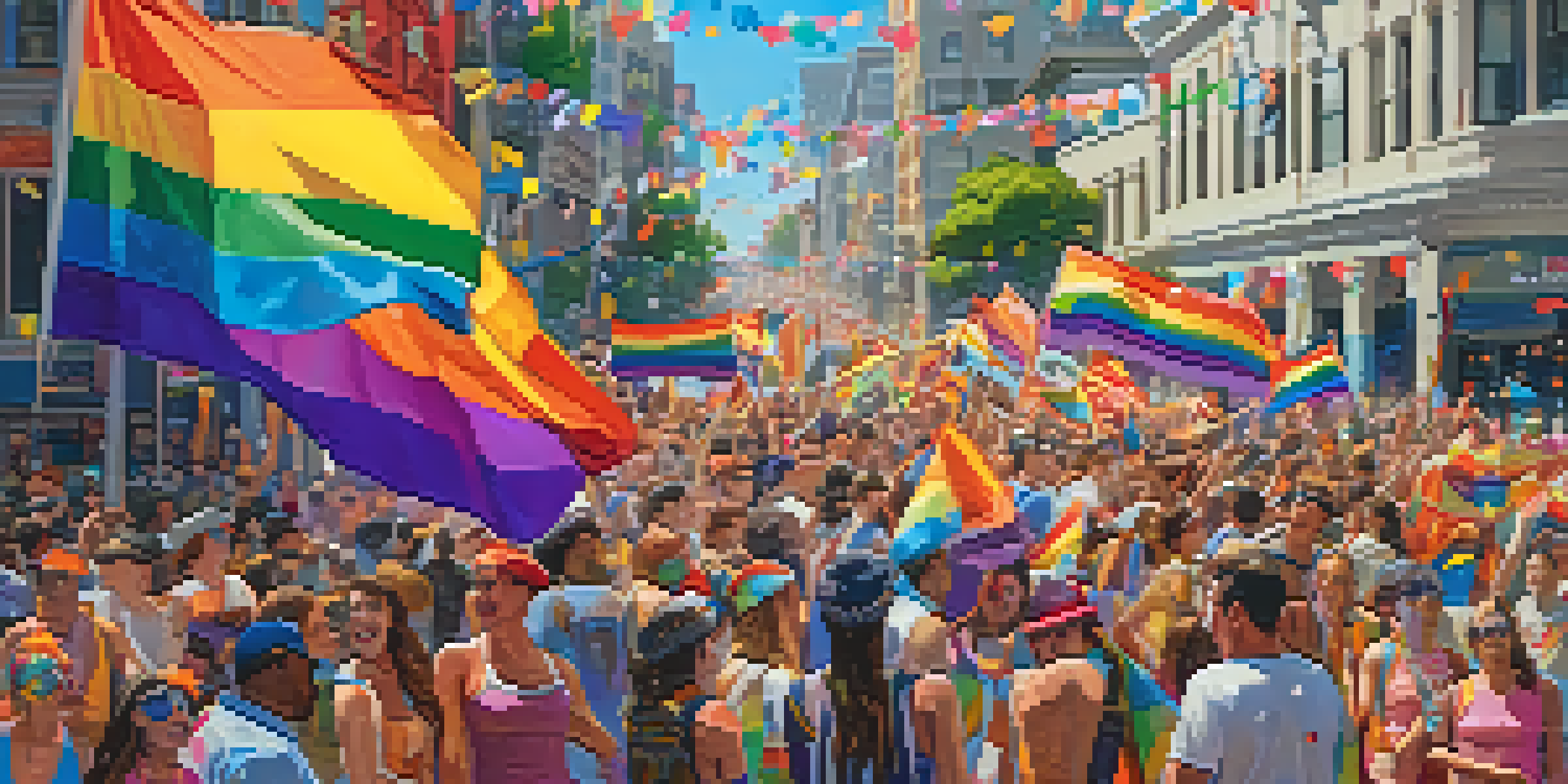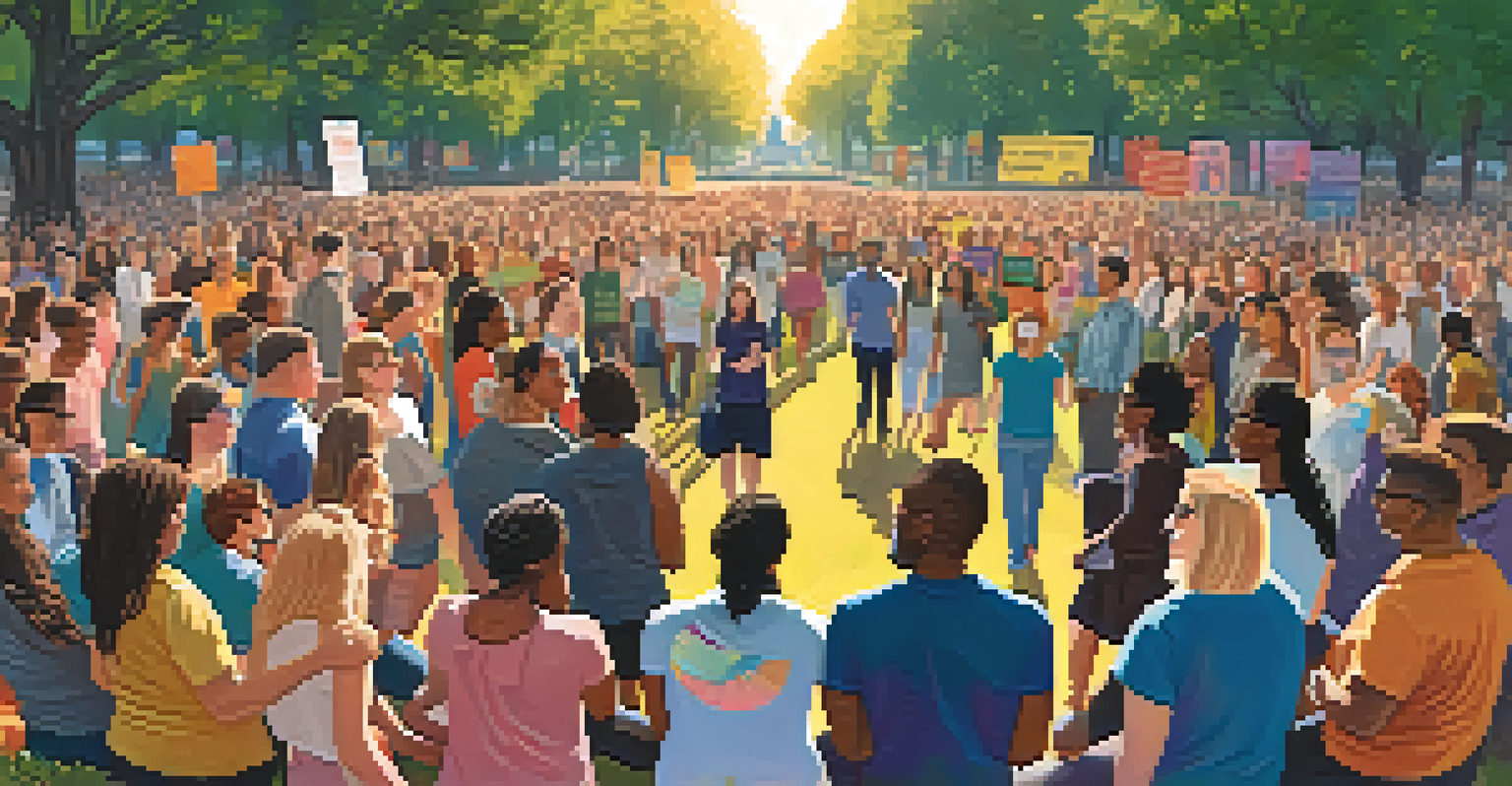The Stonewall Riots: A Catalyst for California's Movement

Understanding the Stonewall Riots: A Brief Overview
The Stonewall Riots, which took place in June 1969, were a series of spontaneous demonstrations by members of the LGBTQ+ community in response to a police raid at the Stonewall Inn in New York City. This event is often viewed as a pivotal moment in the fight for LGBTQ+ rights. The bravery and resistance shown by the patrons of the Stonewall Inn inspired countless others to stand up against oppression and discrimination.
You gotta give 'em hope.
Before Stonewall, many LGBTQ+ individuals lived in fear of persecution, often hiding their identities to avoid violence and discrimination. The riots marked a turning point, showcasing the community's desire for visibility, acceptance, and equality. This sense of empowerment quickly spread beyond New York, igniting activism in cities across the country, including California.
In California, the ripples of Stonewall began to take shape, as activists rallied together to create organizations and events aimed at raising awareness and fighting for their rights. The spirit of resilience and solidarity seen during the riots laid the groundwork for a more organized and vocal movement in the years that followed.
California's Response: The Birth of Activism
In the wake of the Stonewall Riots, California became a hotbed for LGBTQ+ activism, as individuals and groups mobilized to advocate for change. Organizations like the Gay Liberation Front emerged, and protests began to take place in cities such as San Francisco and Los Angeles. This grassroots activism was fueled by the desire for recognition and rights that had long been denied.

One of the first major events highlighting this activism was the Christopher Street West Parade in 1970, which celebrated the anniversary of the Stonewall Riots. This event not only brought visibility to the LGBTQ+ community but also encouraged individuals to embrace their identities openly. The parade became an annual tradition, evolving into what we now know as Los Angeles Pride.
Stonewall Ignited LGBTQ+ Activism
The Stonewall Riots in 1969 marked a crucial turning point, inspiring the LGBTQ+ community to fight for visibility and equality.
As more people began to participate in these events, the sense of community grew stronger. Activists utilized the newfound energy from Stonewall to push for legislative changes, including anti-discrimination laws and the decriminalization of homosexuality. California became a model for LGBTQ+ rights activism, inspiring movements in other states.
Key Figures in California's LGBTQ+ Movement
Prominent figures emerged from California's LGBTQ+ movement, each playing a significant role in advocating for rights and representation. One notable activist was Harvey Milk, who became the first openly gay elected official in California. His election to the San Francisco Board of Supervisors in 1977 was a monumental achievement, symbolizing progress and paving the way for future LGBTQ+ leaders.
The most common way people give up their power is by thinking they don’t have any.
Harvey Milk's legacy extends beyond his political career; he inspired countless individuals to embrace their identities and fight for their rights. His famous motto, 'You gotta give 'em hope,' resonated deeply within the LGBTQ+ community and encouraged many to engage in activism. Milk's assassination in 1978 only strengthened the resolve of activists, who rallied in his memory and continued to push for change.
Other influential figures included Del Martin and Phyllis Lyon, who co-founded the Daughters of Bilitis, the first lesbian rights organization in the U.S. Their work further highlighted the unique challenges faced by lesbian women within the broader movement. Together, these activists created a diverse coalition that amplified voices often marginalized within society.
The Impact of Media on LGBTQ+ Awareness
Media played a pivotal role in shaping public perception of the LGBTQ+ community in California during the post-Stonewall era. Local newspapers and magazines began to feature stories that highlighted the struggles and triumphs of LGBTQ+ individuals, helping to humanize the movement. This increased visibility contributed to a growing acceptance and understanding among the general public.
Television also became an important platform for LGBTQ+ representation, with shows gradually introducing queer characters and storylines. Programs like 'The Advocate' and later 'Will & Grace' helped to normalize LGBTQ+ identities and issues in mainstream culture. This representation was vital in countering stereotypes and fostering empathy among viewers.
California: A Hub for Change
In the aftermath of Stonewall, California emerged as a key region for LGBTQ+ activism, leading to significant legislative advancements and community-building efforts.
As media coverage grew, it also encouraged more individuals to come out and share their experiences. The power of storytelling became evident, as people connected with personal narratives that reflected their own lives. This openness helped to dismantle prejudices and build solidarity within and outside the community.
Legislative Changes Sparked by Activism
The activism that blossomed in California following the Stonewall Riots led to significant legislative changes that improved the lives of LGBTQ+ individuals. Throughout the 1970s and 1980s, activists worked tirelessly to advocate for anti-discrimination laws, culminating in the passage of the California Fair Employment and Housing Act. This landmark legislation prohibited discrimination based on sexual orientation in employment and housing.
In the years that followed, activists continued to push for equality, leading to further legal recognition of LGBTQ+ rights. The fight for marriage equality gained momentum in California, culminating in the landmark 2008 ruling by the California Supreme Court that allowed same-sex couples to marry. This victory was a testament to the decades of hard work and advocacy that followed Stonewall.
Though challenges remained, the progress made in California served as a beacon of hope for LGBTQ+ communities across the nation. The state became a model for inclusivity and acceptance, inspiring other regions to challenge discriminatory practices and embrace diversity.
The Role of Pride Events in Building Community
Pride events have become a cornerstone of the LGBTQ+ movement in California, providing a space for celebration, solidarity, and activism. These annual events not only commemorate the Stonewall Riots but also serve as a reminder of the ongoing fight for rights and equality. Pride parades in cities like San Francisco and Los Angeles attract millions, showcasing the vibrancy and diversity of the LGBTQ+ community.
These gatherings are more than just celebrations; they are also platforms for advocacy and education. Organizations often use Pride events to raise awareness about pressing issues, such as HIV/AIDS, homelessness, and discrimination. By bringing these topics to the forefront, Pride events foster dialogue and encourage individuals to take action.
Media's Role in LGBTQ+ Awareness
Media representation significantly influenced public perception, helping to normalize LGBTQ+ identities and foster empathy during a time of activism.
Moreover, Pride celebrations offer a sense of belonging for many who may have felt isolated due to their identity. The sense of community and acceptance during these events reinforces the message that everyone deserves love and respect, regardless of their sexual orientation or gender identity. This collective spirit continues to inspire new generations of activists.
Looking Ahead: The Future of LGBTQ+ Activism
As we reflect on the impact of the Stonewall Riots and the subsequent growth of California's LGBTQ+ movement, it's essential to consider the future of activism. While significant progress has been made, challenges remain, particularly in areas such as transgender rights and intersectionality within the movement. Activists are increasingly recognizing the need to address these issues to ensure that all voices are heard.
The rise of social media has also transformed the landscape of activism, providing new tools for organizing and mobilizing. Platforms like Twitter and Instagram have allowed activists to share their stories, connect with others, and raise awareness about critical issues in real-time. This digital shift offers exciting new possibilities for grassroots organizing.

Looking ahead, the LGBTQ+ movement in California will continue to evolve, guided by the lessons learned from the past. By embracing diversity and advocating for a more inclusive future, activists can build on the legacy of the Stonewall Riots and work towards a world where everyone can live authentically and without fear.